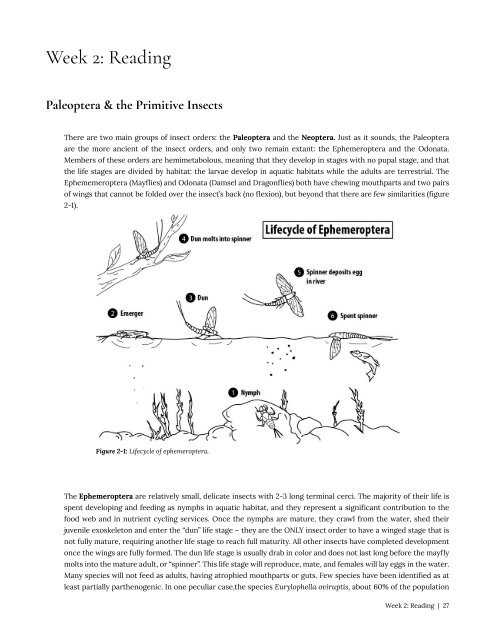Entomology 311 Lab Manual - 1st Edition, 2019
Entomology 311 Lab Manual - 1st Edition, 2019
Entomology 311 Lab Manual - 1st Edition, 2019
You also want an ePaper? Increase the reach of your titles
YUMPU automatically turns print PDFs into web optimized ePapers that Google loves.
Week 2: Reading<br />
Paleoptera & the Primitive Insects<br />
There are two main groups of insect orders: the Paleoptera and the Neoptera. Just as it sounds, the Paleoptera<br />
are the more ancient of the insect orders, and only two remain extant: the Ephemeroptera and the Odonata.<br />
Members of these orders are hemimetabolous, meaning that they develop in stages with no pupal stage, and that<br />
the life stages are divided by habitat: the larvae develop in aquatic habitats while the adults are terrestrial. The<br />
Ephememeroptera (Mayflies) and Odonata (Damsel and Dragonflies) both have chewing mouthparts and two pairs<br />
of wings that cannot be folded over the insect’s back (no flexion), but beyond that there are few similarities (figure<br />
2-1).<br />
Figure 2-1: Lifecycle of ephemeroptera.<br />
The Ephemeroptera are relatively small, delicate insects with 2-3 long terminal cerci. The majority of their life is<br />
spent developing and feeding as nymphs in aquatic habitat, and they represent a significant contribution to the<br />
food web and in nutrient cycling services. Once the nymphs are mature, they crawl from the water, shed their<br />
juvenile exoskeleton and enter the “dun” life stage – they are the ONLY insect order to have a winged stage that is<br />
not fully mature, requiring another life stage to reach full maturity. All other insects have completed development<br />
once the wings are fully formed. The dun life stage is usually drab in color and does not last long before the mayfly<br />
molts into the mature adult, or “spinner”. This life stage will reproduce, mate, and females will lay eggs in the water.<br />
Many species will not feed as adults, having atrophied mouthparts or guts. Few species have been identified as at<br />
least partially parthenogenic. In one peculiar case,the species Eurylophella oviruptis, about 60% of the population<br />
Week 2: Reading | 27


















